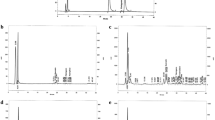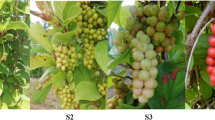Abstract
Flavonoid 3′-hydroxylase (F3′H) and 3′,5′-hydroxylase (F3′5′H) generate precursor molecules for the synthesis of cyanidin-based anthocyanins (red) and delphinidin-based anthocyanins (blue to purple) in Ribes nigrum L. (black currant). In this study, full-length 1780 and 1650-bp cDNA homologs of RnF3′5′H1 and RnF3′H1 from black currant were identified and cloned using a homologous cloning technique. Data revealed that Rn F3′5′H1 and RnF3′H1 are homologs that encode enzymes involved in anthocyanin synthesis from different plants, which phylogenetically cluster with the CYP75B and CYP75A families in the P450 superfamily, respectively. The enzymes encoded by these two genes also shared a high homology with flavonoid hydroxylases identified from other plants. Furthermore, RnF3′5′H1 and RnF3′H1 levels were upregulated during fruit maturation. RnF3′5′H1 levels were associated with both anthocyanin and soluble carbohydrate levels in blackcurrant, while RnF3′H1 expression did not have such an association. The structure and expression patterns of RnF3′5′H1 and RnF3′H1 in blackcurrant were also characterized. Further studies should aid understanding of anthocyanin biosynthesis in black currant to develop molecular approaches and manipulate anthocyanin production in blackcurrant.





Similar content being viewed by others
References
Bogs J, Ebadi A, McDavid D, Robinson SP (2006) Identification of the flavonoid hydroxylases from grapevine and their regulation during fruit development. Plant Physiol 140(1):279–291
Bohm BA (1998) Introduction to Flavonoids. Harwood Academic Publishers, Amsterdam, pp 339–364
Brugliera F, Barri-Rewell G, Holton TA, Mason JG (1999) Isolation and characterization of a flavonoid 3′-hydroxylase cDNA clone corresponding to the Ht1 locus of Petunia hybrida. Plant J 19(4):441–451
Castellarin SD, Matthews MA, Di Gaspero G, Gambetta GA (2007) Water deficits accelerate ripening and induce changes in gene expression regulating flavonoid biosynthesis in grape berries. Planta 227(1):101–112
Chen Y, Mao Y, Liu H, Yu F, Li S, Yin T (2014) Transcriptome analysis of differentially expressed genes relevant to variegation in peach flowers. PLoS ONE 9(6):e90842
Czemmel S, Heppel SC, Bogs J (2012) R2R3 MYB transcription factors: key regulators of the flavonoid biosynthetic pathway in grapevine. Protoplasma 249(Suppl 2):S109–S118
Diaconeasa Z, Leopold L, Rugină D, Ayvaz H, Socaciu C (2015) Antiproliferative and antioxidant properties of anthocyanin rich extracts from blueberry and blackcurrant juice. Int J Mol Sci 16:2352–2365
Forkmann G, Ruhnau B (1987) Distinct substrate specific of dihydroflavonol-4-reductase from flower of Petunia hybrida. Plant Mol Biol 13:491–502
Graham SE, Peterson JA (1999) How similar are P450 s and what can their differences teach us? Arch Biochem Biophys 369(1):24–29
Grotewold E (2006) The genetics and biochemistry of floral pigments. Annu Rev Plant Biol 57:761–780
Halbwirth H (2010) The creation and physiological relevance of divergent hydroxylation patterns in the flavonoid pathway. Int J Mol Sci 11(2):595–621
Halliwell B, Rafter J, Jenner A (2005) Health promotion by flavonoids, tocopherols, tocotrienols, and other phenols: direct or indirect effects? Antioxidant or not? Am J Clin Nutr 81(1 Suppl):268s–276s
Han Y, Vimolmangkang S, Soria-Guerra RE, Rosales-Mendoza S, Zheng D, Lygin AV, Korban SS (2010) Ectopic expression of apple F3′H genes contributes to anthocyanin accumulation in the Arabidopsis tt7 mutant grown under nitrogen stress. Plant Physiol 153(2):806–820
Harborne JB, Williams CA (2000) Advances in flavonoid research since 1992. Phytochemistry 55(6):481–504
Holton TA, Brugliera F, Lester DR, Tanaka Y, Hyland CD, Menting JG, Lu CY, Farcy E, Stevenson TW, Cornish EC (1993) Cloning and expression of cytochrome P450 genes controlling flower colour. Nature 366(6452):276–279
Jeong ST, Goto-Yamamoto N, Hashizume K, Esaka M (2006) Expression of the flavonoid 3′ hydroxylase and flavonoid-3′5′-hydroxylase genes and flavonoid composition in grape (Vitis vinfiera). Plant Sci (Amsterdam, Netherlands) 170(1):61–69
Koes R, Verweij W, Quattrocchio F (2005) Flavonoids: a colorful model for the regulation and evolution of biochemical pathways. Trends Plant Sci 10(5):236–242
Koponen JM, Happonen AM, Mattila PH, Torronen AR (2007) Contents of anthocyanins and ellagitannins in selected foods consumed in Finland. J Agric Food Chem 55(4):1612–1619
Lou Q, Liu Y, Qi Y, Jiao S, Tian F, Jiang L, Wang Y (2014) Transcriptome sequencing and metabolite analysis reveals the role of delphinidin metabolism in flower colour in grape hyacinth. J Exp Bot 65(12):3157–3164
Maatta-Riihinen KR, Kamal-Eldin A, MattilaPH Gonzalez-Paramas AM, Torronen AR (2004) Distribution and contents of phenolic compounds in eighteen Scandinavian berry species. J Agric Food Chem 52(14):4477–4486
Mazza G, Miniati E (1993) Anthocyanins in fruits, vegetables, and grains. CRC Press, Boca Raton, p p362
Nakatsuka T, Nishihara M, Mishiba K, Yamamura S (2005) Temporal expression of flavonoid biosynthesis-related genes regulates flower pigmentation in gentian plants. Plant Sci 168(5):1309–1318
Olsen KM, Hehn A, Jugde H, Slimestad R, Larbat R, Bourgaud F, Lillo C (2010) Identification and characterisation of CYP75A31, a new flavonoid 3′5′-hydroxylase, isolated from Solanum lycopersicum. BMC Plant Biol 10:21
Pascual-Teresa SD, Sanchez-Ballesta MT (2008) Anthocyanins: from plant to health. Phytochem Rev 7:281–299
Pirie A, Mullins MG (1976) Changes in anthocyanin and phenolics content of grapevine leaf and fruit tissues treated with sucrose, nitrate, and abscisic Acid. Plant Physiol 58(4):468–472
Quattrocchio F, Wing JF, Leppen H, Mol J, Koes RE (1993) Regulatory genes controlling anthocyanin pigmentation are functionally conserved among plant species and have distinct sets of target genes. Plant Cell 5(11):1497–1512
Saito K, Yonekura-Sakakibara K, Nakabayashi R, Higashi Y, Yamazaki M, Tohge T, Fernie AR (2013) The flavonoid biosynthetic pathway in Arabidopsis: structural and genetic diversity. Plant Physiol Biochem 72:21–34
Sakakibara H, Honda Y, Nakagawa S, Ashida H, Kanazawa K (2003) Simultaneous determination of all polyphenols in vegetables, fruits, and teas. J Agric Food Chem 51(3):571–581
Schoenbohm C, Martens S, Eder C, Forkmann G, Weisshaar B (2000) Identification of the Arabidopsis thaliana flavonoid 3′-hydroxylase gene and functional expression of the encoded P450 enzyme. Biol Chem 381(8):749–753
Tanaka Y, Brugliera F (2013) Flower colour and cytochromes P450. Philos Trans R Soc Lond B Biol Sci 368(1612):1–14
Tanaka Y, Ohmiya A (2008) Seeing is believing: engineering anthocyanin and carotenoid biosynthetic pathways. Curr Opin Biotechnol 19(2):190–197
Tanaka Y, Yonekura K, Fukuchi-Mizutani M, Fukui Y, Fujiwara H, Ashikari T, Kusumi T (1996) Molecular and biochemical characterization of three anthocyanin synthetic enzymes from Gentiana triflora. Plant Cell Physiol 37(5):711–716
Taylor B, Powell A (1982) Isolation of plant DNA and RNA. Focus 4:4–6
Toda K, Akasaka M, Dubouzet EG, Kawasaki S, Takahashi R (2005) Structure of flavonoid 3′-hydroxylase gene for pubescence color in soybean. Crop Sci 45(6):2212–2217
Uimari A, Strommer J (1998) Anthocyanin regulatory mutations in pea: effects on gene expression and complementation by R-like genes of maize. Mol Gen Genet 257(2):198–204
Wang J, Ming F, Han Y, Shen D (2006) Flavonoid-3′,5′-hydroxylase from Phalaenopsis: a novel member of cytochrome P450 s, its cDNA cloning, endogenous expression and molecular modeling. Biotechnol Lett 28(5):327–334
Werck-Reichhart D, Feyereisen R (2000) Cytochromes P450: a success story. Genome Biol 1(6):3003-1–3003.9
Winkel-Shirley B (2001) Flavonoid biosynthesis. A colorful model for genetics, biochemistry, cell biology, and biotechnology. Plant Physiol 126(2):485–493
Wu X, Beecher GR, Holden JM, Haytowitz DB, Gebhardt SE, Prior RL (2006) Concentrations of anthocyanins in common foods in the United States and estimation of normal consumption. J Agric Food Chem 54(11):4069–4075
Xia X, Xie Z (2001) DAMBE: data analysis in molecular biology and evolution. J Hered 92:371–373
Xu B, Li J, Zhang X (2007) Cloning and molecular characterization of a functional flavonoid 3 of Petunia hybrida. Journal Physiol 164(3):350–363
Author information
Authors and Affiliations
Corresponding author
Additional information
Project Funding: This study was supported by Heilongjiang Natural Science Foundation (Grant No. C2016015) with a project titled “Biological function analysis of F3′5′H gene of black currant (Ribes nigrum L.)”.
The online version is available at http://www.springerlink.com
Corresponding editor: Zhu Hong.
Electronic supplementary material
Below is the link to the electronic supplementary material.
Rights and permissions
About this article
Cite this article
Li, Xg., Yang, Tt., Yu, Zy. et al. Cloning of flavonoid 3′,5′-hydroxylase and 3′-hydroxylase homologs from black currant (Ribes nigrum) and their differential expression at various fruit maturation stages. J. For. Res. 30, 463–470 (2019). https://doi.org/10.1007/s11676-017-0560-y
Received:
Accepted:
Published:
Issue Date:
DOI: https://doi.org/10.1007/s11676-017-0560-y




